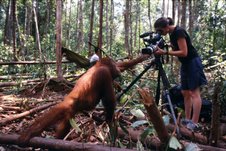An Article from New Scientist in 2002, but still as relevant four years on as huge swathes of forest are cleared from peat domes, under the guise of palm oil development. It is important to note that oil palm does not grow well on peat, it falls over, machinery sinks, and the fire risks should mean that previously cleared, dry lowland should be used before opening peat swamp forests. We shouldn't even need to raise the point that peat swamp forest is one of the last refuges for orangutans!
N.L., OFPP
Indonesian wildfires spark global warming fears
19:00 06 November 2002
Copyright NewScientist.com news service 2002
By Fred Pearce
Burning peat bogs in Indonesia are releasing massive amounts of carbon dioxide into the atmosphere, in a repeat of the environmental devastation that made headlines around the world five years ago.
Tropical peat bogs, such as those beneath the forests of Indonesia, are among the planet's largest stores of carbon. They release much more CO2 when they burn than when the trees that grow on them catch fire.
Now a team of scientists from Britain, Germany and Indonesia has reported that as Indonesia's forests burned in 1997, the smouldering peat beneath released as much as 2.6 billion tonnes of carbon into the air.
That is equivalent to 40 per cent of the global emissions from burning fossil fuels that year, and was the prime cause of the biggest annual increase in atmospheric CO2 levels since records began more than 40 years ago.
Deep burn
The researchers calculate that, in 1998, the atmosphere contained almost 6 billion extra tonnes of CO2, compared with an annual average for the 1990s of 3.2 billion tonnes. Researcher Susan Page of the University of Leicester estimates that the smouldering peat bogs lost between 25 and 85 centimetres in depth.
Indonesian bogs burning during this year's El Niño are again spreading smog across southeast Asia, says her colleague Jack Rieley of the University of Nottingham. "The burning is likely to be around 40 per cent of 1997 levels, releasing up to a billion tonnes of carbon," he told New Scientist.
Formed over the past 20,000 years, Indonesia's peat bogs are up to 20 metres deep. Huge areas have been drained for agricultural projects in recent years. This leaves the peat dry and prone to fires spread when farmers clear the forest, especially when the rains fail in El Niño years.
In 1997, only 4.5 per cent of the pristine swamp areas burned, compared with 70 per cent of swamp beneath fragmented forest, the study found.
Carbon credits
As much as 50 billion tonnes of carbon is locked up in Indonesia's peat bogs - the equivalent of eight years of fossil-fuel emissions. Rieley predicts that it could all be released into the atmosphere over the coming century, adding to global warming.
David Schimel of the National Center for Atmospheric Research in Boulder, Colorado, says the study reveals how "catastrophic events affecting small areas can have a huge impact on the global carbon balance."
Rieley is now calling for an international effort to save the bogs. He says the Kyoto Protocol on climate change, which issues "carbon credits" to countries planting new forest to soak up CO2, should be extended to allow countries to claim credits for protecting key carbon stores such as peat bogs. Selling the credits to polluters could finance conservation projects, he says.
Journal reference: Nature (vol 420, p 61)
![]()
![]()


![]()



